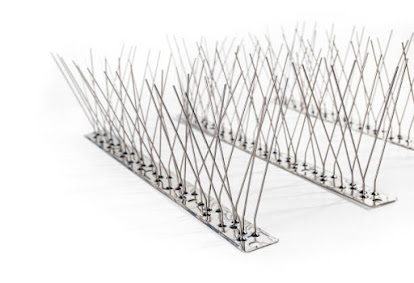Bird Spikes Preserving Historical Sites with Modern Solutions
Introduction
Preserving historical sites presents a unique set of challenges, with environmental factors often posing unforeseen threats to the integrity of these cherished landmarks. One such challenge is the presence of birds, whose perching and nesting behaviors can cause damage to historic structures. However, modern solutions, such as bird spikes, offer a non-intrusive and effective method for protecting these sites while maintaining their aesthetic and historical value. This essay explores the advantages of using bird spikes in historical preservation efforts, highlighting their efficacy, non-destructive nature, and compatibility with conservation principles.Understanding the Threat
Bird spikes in dubai, while admired for their beauty and symbolism, can inadvertently pose significant risks to historical buildings and monuments. Their nesting activities can lead to the accumulation of droppings, feathers, and debris, causing unsightly staining and corrosion of delicate surfaces. Additionally, the acidic nature of bird droppings can accelerate the deterioration of building materials, particularly stone, metal, and wood, compromising the structural integrity of these structures over time.
Moreover, the presence of birds can deter visitors from enjoying these historical sites, impacting tourism and diminishing their cultural significance. For example, the fouling caused by birds can create unsanitary conditions, deterring visitors and tarnishing the site's reputation.
Traditional Methods and Limitations
Historically, various methods have been employed to deter birds from roosting and nesting on historical structures. These include the use of netting, spikes, wires, and chemical deterrents. While some of these methods may offer temporary relief, they often come with significant drawbacks.
For instance, netting can be visually obtrusive and detract from the architectural beauty of the site. Moreover, it may not be suitable for protecting intricate or delicate features of historical buildings. Similarly, chemical deterrents raise concerns about environmental and human health risks, as well as potential damage to the building materials.
The Advantages of Bird Spikes
In recent years, bird spikes have emerged as a preferred solution for addressing bird-related issues in historical preservation. Bird spikes consist of thin, pointed rods made of durable materials such as stainless steel or polycarbonate, which are affixed to surfaces where birds tend to perch or roost. Unlike other methods, bird spikes offer several distinct advantages:
Non-Destructive Installation: Bird spikes installation dubai can be installed without causing any damage to the historical fabric of the building. They can be securely attached using adhesives, screws, or other non-invasive methods, preserving the integrity of the structure while effectively deterring birds.
Aesthetic Compatibility: One of the key benefits of bird spikes is their discreet and unobtrusive design. Unlike netting or wires, which can mar the visual appeal of historical buildings, bird spikes blend seamlessly with the architecture, ensuring that the site's historical and aesthetic value remains intact.
Humane Deterrent: Bird spikes provide a humane deterrent that does not harm birds. Instead of relying on harmful chemicals or physical barriers, bird spikes simply create an uncomfortable surface for birds to land on, prompting them to seek alternative roosting sites without causing them harm.
Long-Term Effectiveness: Bird spikes offer long-lasting protection against bird infestation. Made of durable materials, they are resistant to weathering and degradation, ensuring continued efficacy over time. This longevity makes bird spikes a cost-effective solution for preserving historical sites in the face of avian threats.
Environmental Friendliness: Unlike chemical deterrents, which can have harmful effects on the environment, bird spikes pose no risk to ecosystems or wildlife. They provide a sustainable and environmentally friendly method for managing bird populations while safeguarding historical structures.
Case Studies: Bird Spikes in Action
Numerous historical preservation projects around the world have successfully utilized bird spikes to protect iconic landmarks and architectural treasures. One notable example is the Tower of London, a UNESCO World Heritage Site renowned for its rich history and architectural splendor. The Tower faced persistent bird-related challenges, with pigeons and other avian species causing damage to its stonework and posing hygiene concerns for visitors.
To address these issues, conservationists installed bird spikes discreetly along ledges and parapets, effectively deterring birds without compromising the Tower's historic character. The use of bird spikes not only preserved the integrity of this iconic landmark but also enhanced the visitor experience by ensuring a clean and welcoming environment.
Similarly, the Taj Mahal in India, a masterpiece of Mughal architecture and a symbol of enduring love, faced threats from bird activity that jeopardized its pristine white marble facade. Concerned about the impact of bird droppings on the monument's delicate surfaces, conservationists opted to install bird spikes in strategic locations, safeguarding the Taj Mahal from avian damage while preserving its timeless beauty for future generations to admire.
Conclusion
Preserving historical sites requires innovative solutions that balance the need for conservation with the imperative to protect these cultural treasures from environmental threats. Bird spikes offer a compelling approach to managing bird-related issues in historical preservation, providing effective, non-destructive, and environmentally friendly protection for iconic landmarks and architectural gems.
By leveraging the advantages of bird spikes, conservationists can safeguard historical structures from the corrosive effects of bird activity while ensuring that their architectural and cultural significance remains intact. As exemplified by the success stories of the Tower of London and the Taj Mahal, bird spikes have become indispensable tools in the arsenal of modern conservationists, enabling them to protect the past for the enjoyment and enrichment of future generations.


.jfif)

Comments
Post a Comment